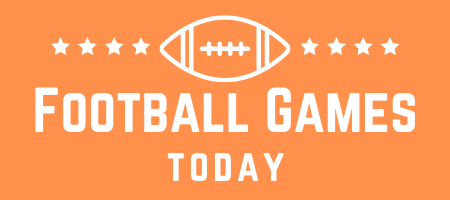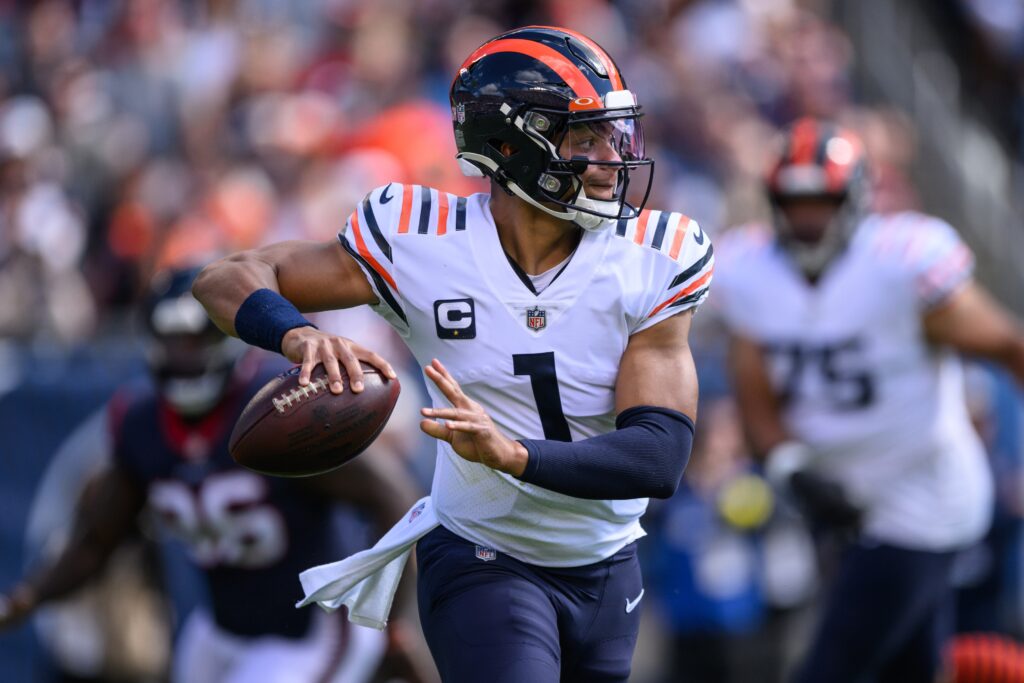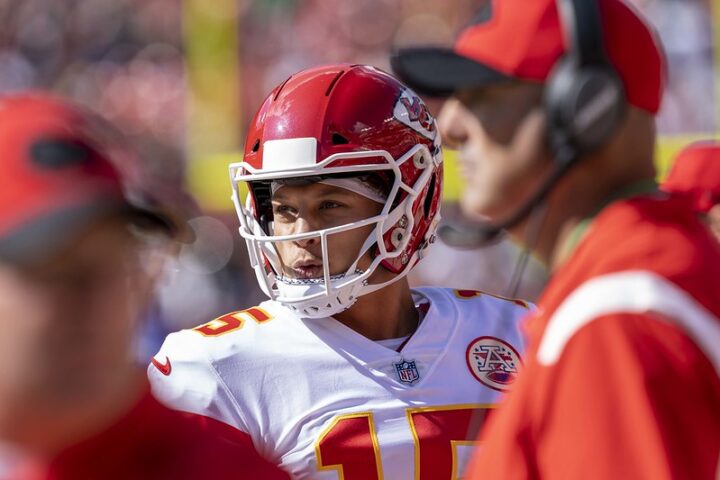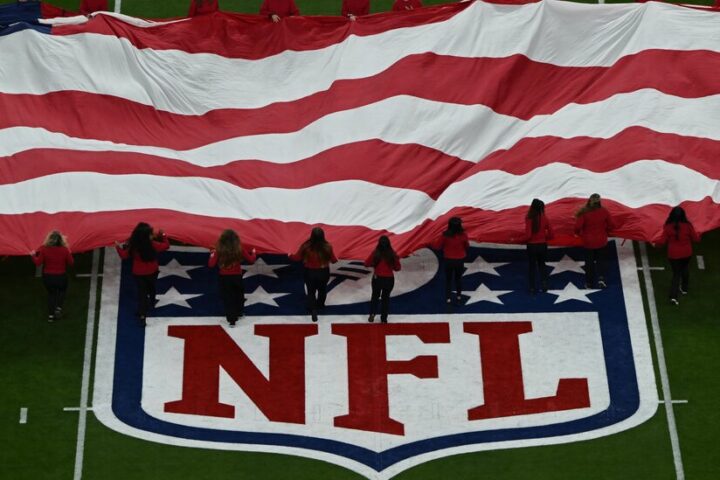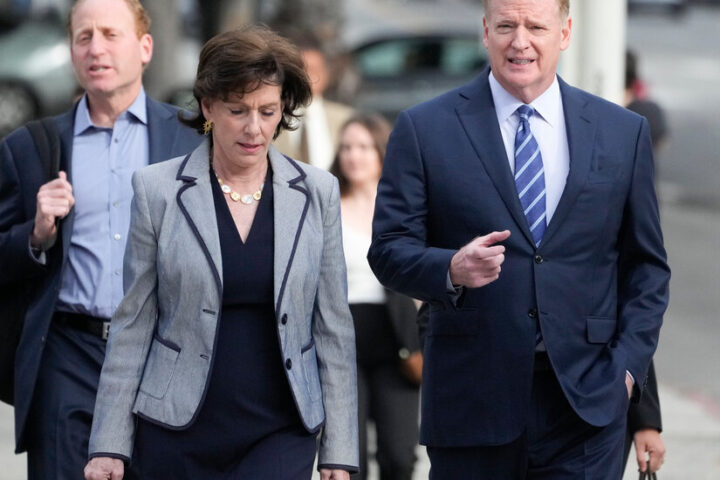The Chicago Bears overhauled their roster after producing the worst record in the NFL in 2022. After seeing quarterback Justin Fields drag their offense with a historical rushing performance, the team fully committed to building around him entering his third season.
Now it’s time for Fields to return the favor. We dive into what Fields must show the Bears in 2023 to prove he’s their franchise quarterback moving forward.
How Justin Fields Can Prove To Be Bears’ Franchise QB
There are two sides to player development. The player, of course, must work as hard as possible to maximize their strengths and minimize their weaknesses. The team must also provide the infrastructure and talent around the player to ensure they’re in a position to succeed.
In Fields’ first two seasons with the Bears, the franchise completely failed him.
In 2021, the Bears’ coaching staff was unable to field a moderately productive unit despite having talent that was valued elsewhere, including Allen Robinson, Marquise Goodwin, and Jakeem Grant. It wasn’t a stellar cast, but with Darnell Mooney, Cole Kmet, and David Montgomery proving to be capable producers at the top of the roster, there was enough depth and specialized skill for the offense to be much more effective.
Once Matt Nagy and his staff were cleared out after the season, the Bears entered a teardown mode in 2022. General manager Ryan Poles assembled a truly embarrassing cast of castoffs to play receiver before panicking and trading the 33rd overall pick in the 2023 NFL Draft for Chase Claypool. Claypool, who profiles best as any team’s third receiver, was unable to help the woeful offense.
First-year offensive coordinator Luke Getsy lucked into an effective rushing attack after David Montgomery’s injury opened the door for Khalil Herbert to get snaps. As soon as Herbert played, the Bears benefitted from the 5.7 yards per carry he produced. It was in Week 6 when Fields had to take things more into his own hands after getting pummeled behind a bad offensive line and unable to find open receivers in Getsy’s simplified attack.
MORE: FREE Mock Draft Simulator With Trades
From Week 6 on, Fields ran for less than 60 yards in a game just once. He finished with a remarkable 1,143 rushing yards and eight touchdowns, giving the Bears the top rushing game in the NFL. But it came with a price, as he missed two games with a shoulder sprain and hip strain.
Fields’ passing also improved in terms of decision-making and accuracy despite the lack of help around him. He completed at least 60% of his passes until his final game at Detroit. His air yards per attempt leaped to the eighth-best mark in the league, and his red-zone completion rate was seventh.
Some of Fields’ numbers were tough to consider when the film showed a bad supporting cast. Mooney was notably absent in Getsy’s scheme, producing only 41.1 yards per game and 12.3 yards per catch. Kmet led the team with 544 yards, and then a host of players who aren’t viable NFL talents filled out the rest of their stat sheet.
The Bears saw the same thing as they opted against drafting a quarterback No. 1 overall. Poles gathered an impressive haul to move down to No. 9, grabbing wide receiver DJ Moore in the deal. He also added right tackle Darnell Wright, wide receiver Tyler Scott, backup tight end Robert Tonyan, and replaced Montgomery with D’Onta Foreman.
Poles noted they needed to “wait a little bit to do it,” eluding to the messy cap situation he inherited and the lack of assets the team had when he arrived. But he was clear they had to support Fields better, including adding better blockers and a variety of pass catchers who can create separation. Everything he said owned up to the front office’s previous failures.
MORE: Chicago Bears 2023 Schedule
As ESPN’s Louis Riddick said, now the Bears can “make a much fairer evaluation” about Fields’ ability to develop and lead the franchise. The team has improved a line that allowed 55 sacks last year and a receiving unit that forced Fields to hold on to the ball for far too long.
Fields will also need to show progress in his own controllable ways.
There’s been considerable hand-wringing over Fields’ time to throw being among the highest in the league. Some of that is natural when there’s a bad receiving corps, and some of it is in Fields’ DNA. He showed at Ohio State that he wants to hold the ball in hopes of creating explosive plays, and the time he buys in evading rushers allows him bigger lanes to run upfield when he needs to.
I wouldn’t expect him to suddenly become a pocket passer who never looks to extend plays because that takes away part of what makes Fields so special. But he has to improve getting the ball out faster when that’s the play design. Both Fields and Getsy admitted they work in tandem to include plays Fields likes in the gameplan, and that relationship must continue to evolve.
His play-action and clean-pocket completion rates must massively improve. He was only 33rd off play action despite being an excellent running team. And no offense can win with a quarterback who is 27th at completing passes in a clean pocket.
With improved blocking and receivers, Fields may fare better simply because he’ll have higher-quality targets and benefit from more time and separation. His weaknesses to this point have little to do with physical capabilities and are more born from experience, repetition, and being in the right environment.
We’ll know more about Fields as 2023 develops. It’s been hard to see where he’s been great and bad to this point because of his situation, but the Bears have done well to help Fields paint a better picture of his abilities this season.
